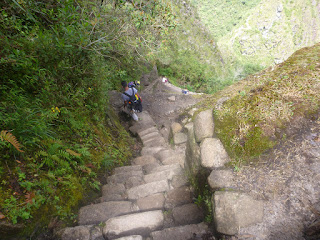Another early morning: we started hiking towards Machu Picchu at 4: 30 am. After half an hour, we crossed the bridge marking the park entrance. From there, we started climbing the roughly 1600 steps to Machu Picchu, covering 400 meters of altitude difference. For about the last third, it was finally light enough to walk without a flashlight. But when we finally got to the top, tired and covered in sweat, we were richly rewarded by seeing the sun rise over the mountains and slowly illuminate Machu Picchu. What a sight!
The purpose of Machu Picchu is not entirely clear: some say it was a religious site where people made pilgrimages to, others say that the ninth Inca Pachacutec built it as a mansion. In either case, it makes sense that only about 200 handpicked people, mostly priests and nobles, lived permanently in Machu Picchu.
By the way, the word Inca strictly speaking only denominates the ruler of the empire. The ordinary people living in the empire were Quechua, like the language spoken in the empire.
Like in many other Inca places, Machu Picchu also had an intricate irrigation system. Some springs were reserved for religious purposes like ritual baths. Others were used for agriculture, with a system of terraces making sure the available space and water were used optimally. All of the terraces in this picture, now planted with grass, were originally used for crops like corn.
The internal structure of the terraces is also fascinating. They are built following an ingenious layered system of different kinds of stone, sand and soil to ensure that the water flows to the terraces below in just the right way.
Machu Picchu is also fascinating in terms of masonry. They purposely employed stones with many sides to increase the stability of the walls, like this one:
It is also very interesting to see how they distinguished between important (temples) and less important (housing) buildings by varying how well the walls were built. This, for example, is a temple wall. In the back, you can see the decidedly less fine construction used for the terraces:
Machu Picchu also had a sun dial that could indicate important dates in the year, like the times to start planting or harvesting, and the time of the Inca's most important festival, Inti Raymi. This festival was, and still is today, held on June 21st, the year's shortest day. On this day, many many llamas (think thousands) were sacrificed to persuade the sun god Inti to stay.
The construction of Machu Picchu was not undertaken in a haphazard way, but was planned carefully. Models were carved in stone for all aspects, from location to the arrangement of the different sectors and the layout of each sector. This stone, for example, is a model of Machu Picchu and the surrounding mountains and rivers.
The location of Machu Picchu was carefully chosen so that it was surrounded on all sides by higher mountains. These mountains, venerated as gods, were believed to protect the site.
One of these mountains is Huayna Picchu, with its 2700m 300 meters higher than Machu Picchu. Every day, 400 visitors are allowed to make the steep climb up to Huayna Picchu. I had heard great things about the view from up there, so of course I had to go too. And this is Huayna Picchu:
The climb up wasn't too bad, but all stairs again. My rough estimation is that I climbed at least 3000 steps that day (and descended that many again) - think about doing 3000 squats, that might come close ;-) Anyway, the view from the top was breathtaking:
And we could also see the street and stair access ways that lead up to Machu Picchu - looks kinda harmless from up there, doesn't it?
On top of Huayna Picchu, birds and small lizards were feasting on the crumbs left behind by the hungry climbers ;-)
The descent was far worse than the ascent because of the steep and narrow steps. Photos can't really convey the steepness, but I tried to capture it anyway:
After Huayna Picchu, we visited the Inca bridge, a small wooden bridge built into the side of a steep cliff. Looking at the thing, I couldn't help but wonder why they bothered to use wood at all instead of just covering it all with stone.
Finally, I decided to climb up to the sun gate to get a view of Machu Picchu from the other side:
The afternoon rain covered Machu Picchu in clouds, offering delightfully mystic views:




















































